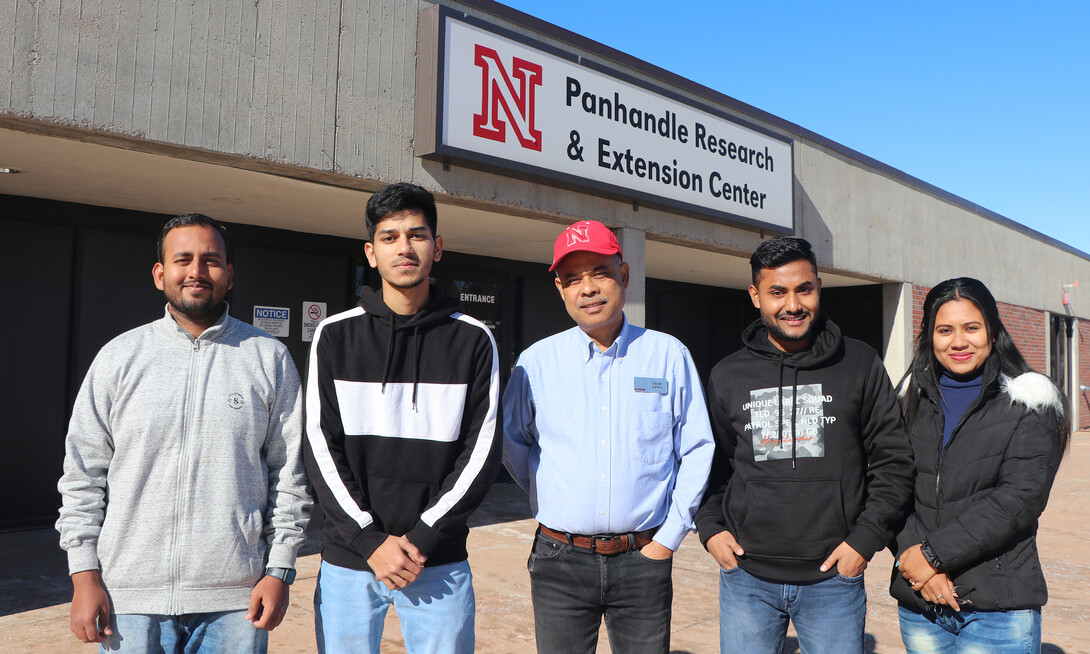
Lincoln, Neb. —Four undergraduate college students from Assam Agricultural University in India have arrived in Scottsbluff, where they will spend about two months studying American agriculture -- everything from technology on tractors to federal policy coming from Washington.
This cohort is the first group of about 40 students from India who will spend time studying in Nebraska this spring. They are coming under the auspices of ICAR, the government of India’s National Agricultural Higher Education Project (NAHEP), designed to strengthen the national agricultural education system in India to provide more relevant and high-quality education to ag university students there.
The connection to Scottsbluff came via a faculty member at the University of Nebraska-Lincoln Panhandle Research, Extension and Education Center, Dipak Santra, the alternative crops breeding specialist. Santra, who came from India, was visiting family there several years ago when he made a connection with several universities there.
While in Scottsbluff, the students will be exposed to a wide variety of people and organizations who are involved in America’s food, fiber and energy-producing sector. Their two-month agenda includes orientation, several weeks of research, a visit to the UNL campus in Lincoln, time to interact with producers and businesses in the regional private agriculture sector, and presenting reports on their experience in Nebraska.
“The students’ primary interest is to learn about American farming technology systems, ag policy, the role of public universities in production agriculture, and private ag industries,” Santra said. “They want to gain knowledge about how university faculty and scientists participate in applied agricultural research and extension to support the American farmers and their families. They are also interested to learn about federal policy to support American agriculture, as well as the marketing system for ag commodities.”
The students have many questions about American agriculture; for example, average farm size, what it’s like to live on a farm, and rural culture and festivals.
India’s NAHEP program promotes efficiency and competitiveness in the nation’s agricultural universities and recruiting talented students.
During a 2019 visit to India, Santra visited Assam Agricultural University (AAU) – where the first group of students came from and where he attended graduate school – and Orissa University of Agriculture and Technology (OUAT). He met with university administrators and faculty to explore collaborations in research and training. India’s NAHEP Project was established to initiate this kind of research training opportunity, he said.
After returning to Scottsbluff, Santra kept in touch and reached an agreement among those universities and UNL for a student and faculty exchange program for intensive training research and education. A general memorandum of understanding among these universities and UNL was established in 2019-20.
Under the auspices of the NAHEP program, Santra hosted nine undergrad agronomy and veterinary science students from OUAT at the Panhandle Center for two months in early 2020. The veterinary students were trained and supervised by retired Panhandle Center Director Jack Whittier and Dale M. Grotelueschen, Professor Emeritus in the UNL Department of Animal Science.
Then the COVID pandemic halted further student groups, but exchanges are now set to resume. The first group of four students arrived on Jan. 31. A second group, composed of veterinary science students, arrives March 1. A third group (agricultural engineering) will come to Lincoln from March until the end of April. The last group (agricultural science) are expected to arrive at the Panhandle Center in April. The number of students and exact dates may vary depending on COVID and their visas.
Santra said the program is made possible by a long list of Investigators, coordinators and mentors. The principal investigators and coordinator (who manage the program, arrange for housing and logistics, and other tasks) are Santra and Bijesh Maharjan, Soil and Nutrient Management Specialist at the Panhandle Center. On-site coordinators are Santra in agricultural science; Whittier in veterinary science; and Chittaranjan Ray, Director, Nebraska Water Center, in agricultural engineering.
Mentors include Santra; Maharjan; Jeff Bradshaw, Entomology Specialist at the Panhandle Center; Whittier; Ray; Grotelueschen; Xin Qiao, Water & Irrigation Management Specialist at the Panhandle Center; Mitch Stephenson, Range and Forage Management Specialist at the Panhandle Center; Pablo Loza, Beef Feedlot Specialist at the Panhandle Center; Santosh Pitla, Advanced Machinery Systems, Biological Systems Engineering, UNL; Yeyin Shi, Agricultural Information System Engineer, Biological Systems Engineering, UNL; and Tirthankar Roy, Civil and Environmental Engineering, UNL.
After returning to India and completing college, some students plan to perform research, some will go to the academy to teach, others plan to join the private sector (in fields such as equipment or marketing), and many students hope to join government service.
“So the students will apply all this training and knowledge they gain in their future jobs in India,” Santra said. “Their overall goal is to use this training to help Indian farmers and Indian agriculture.”
With this collaborative relationship in place with Indian agricultural universities, Santra expects to continue the partnership with Panhandle Center specialists and UNL faculty for years.







